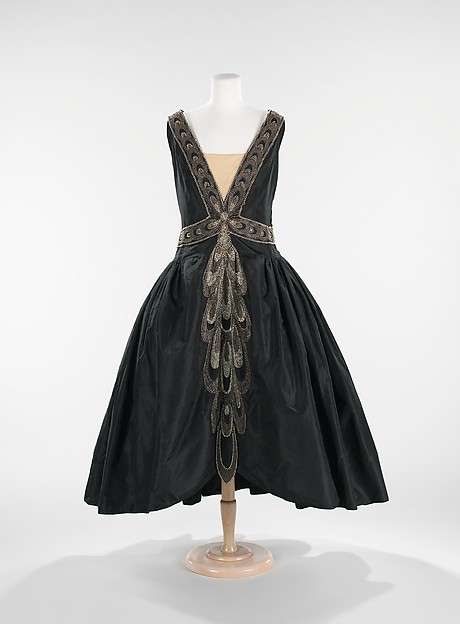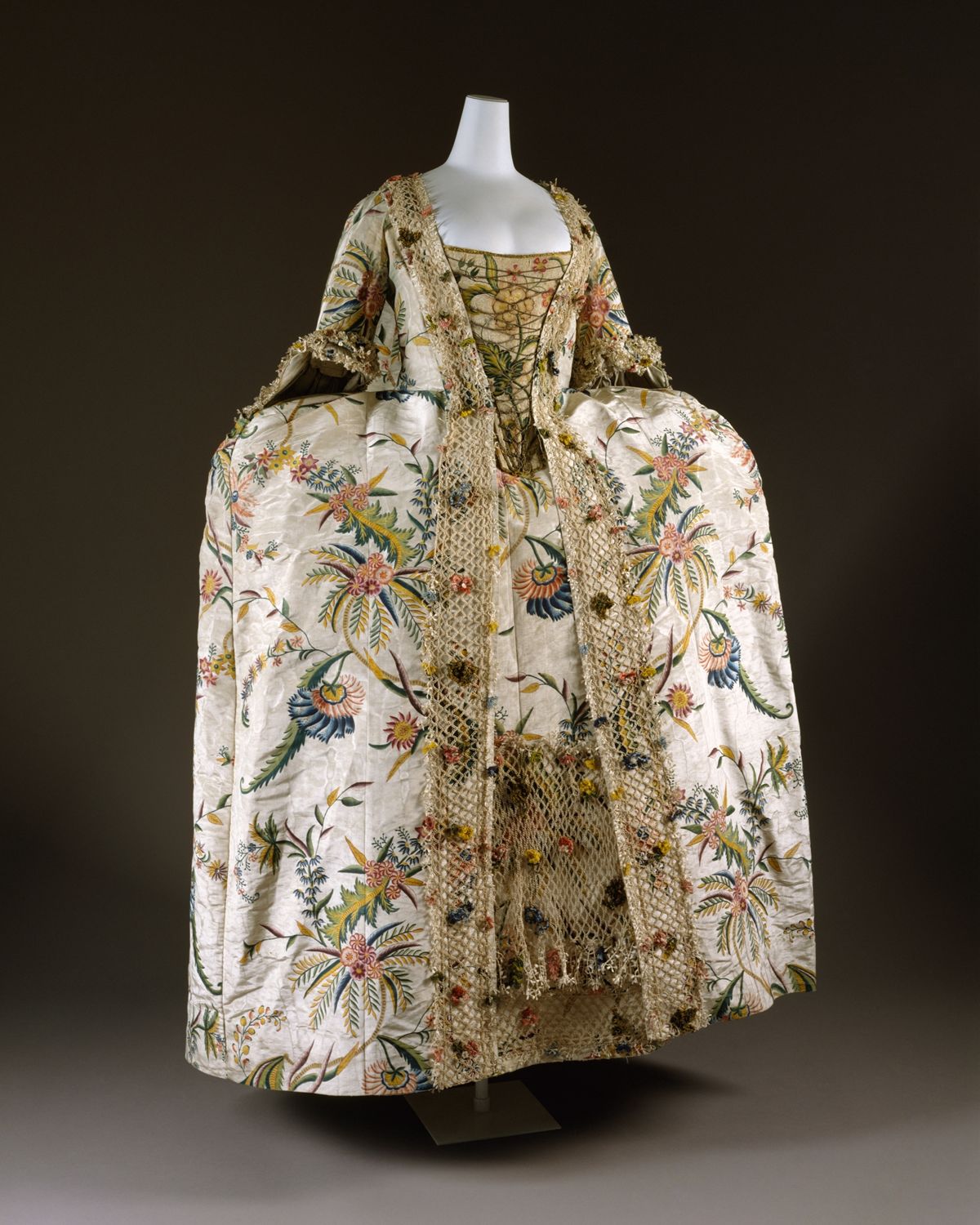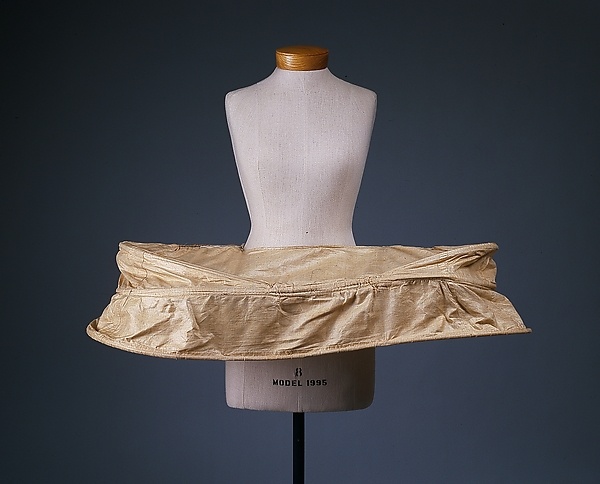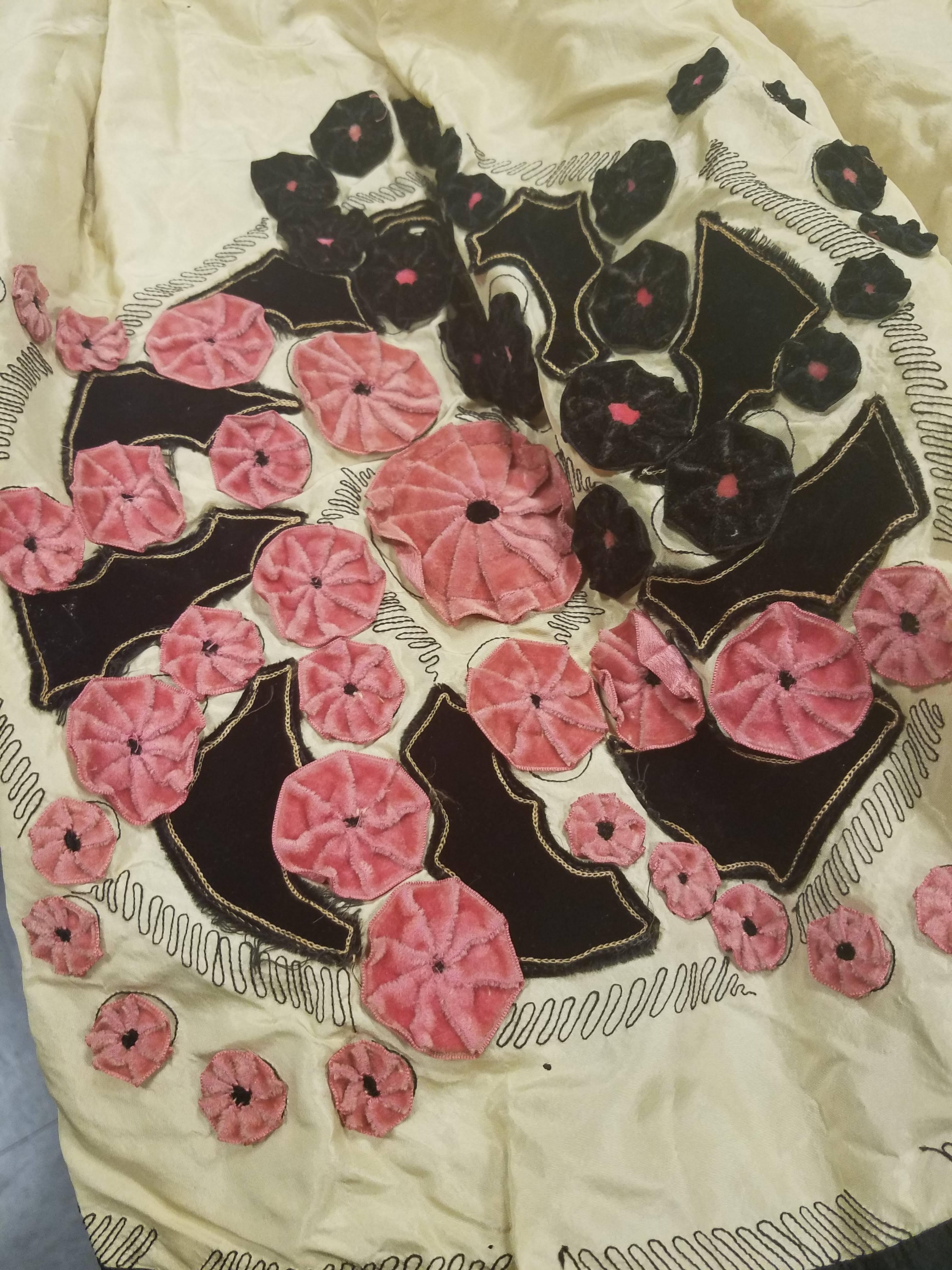Jeanne Lanvin’s Robe de Style: An alternative to “All that Jazz” fashions of the 1920’s
Nora Ellen Carleson, 2018 Summer Fashion Archives Intern
The zeitgeist of 1920’s fashions for most is the short, black, sparkly, beaded flapper dress. Thanks to popular culture powerhouses like Chicago and The Great Gatsby among others, this image of women’s fashion during this time has been cemented into the minds of the masses. However, the 1920s were a time of vibrant colors, a plethora of textures, quickly changing silhouettes, and a wide variance in fashions for women. One trend in particular rebuffed the look of the so called “flapper” dress in favor of a more classical silhouette, the robe de style.

Robe de Style, House of Lanvin, Jeanne Lanvin, French, fall / winter 1926, silk, rhinestones, pearls, Courtesy of the Metropolitan Museum of Art, https://www.metmuseum.org/art/collection/search/157340, 2009.300.2506.
The robe de style, was a style of dress created in the 1920’s by French couture designer Jeanne Lanvin. While elements of the design changed from season to season, at its core, the style was comprised of a dress with a dropped or lower than natural waistline and a full skirt reaching anywhere from mid-calf to ankle with volume or extensions coming from the hips. The robe de style was a highly feminine look that evoked historical Spanish and French dresses of the 17th and 18th centuries, including the Robe a la Francaise, that had extremely large padding and structure on the hips.
 Robe a la Francaise, British, 1740’s, silk, pigment, linen, Courtesy of the Metropolitan Museum of Art, https://www.metmuseum.org/art/collection/search/79893, 1995.235a,b.
Robe a la Francaise, British, 1740’s, silk, pigment, linen, Courtesy of the Metropolitan Museum of Art, https://www.metmuseum.org/art/collection/search/79893, 1995.235a,b.

Panniers, British, ca. 1750, linen, cane, Courtesy of the Metropolitan Museum of Art, https://www.metmuseum.org/toah/works-of-art/1973.65.2/, 1973.65.2.
Lanvin’s robe de style was created with youthful and graceful women in mind who wanted a more classical look that spoke to luxury, wealth, and high social status of the century old dresses and their wearers that had inspired the design. The robe de style, though created by Lanvin was made by other designers as well, including the famous Paul Poiret. Furthermore, like any other couture of the day it was copied by American and English dressmakers as well. Nevertheless, as a type of alternative fashion, the robe de style was not adopted by the majority of women in its day and are more difficult to find than the “flapper” style dresses of the 1920s. However, the Maryland Historical Society Fashion Archives boasts two fantastic examples of mid-to-late 1920s robe de style dresses.

Robe de style, unknown, likely French, ca.1927-1928, Maryland Historical Society, Gift of Mrs. Campbell Lloyd Sterling, 1974.14.2.

Robe de style (top detail), unknown, likely French, ca.1927-1928, Maryland Historical Society, Gift of Mrs. Campbell Lloyd Sterling, 1974.14.2.
The first robe de style in the MdHS collection does not have a label, but was likely made in France. Made of bright pink silk satin, cherry red silk velvet, metallic thread, and sparkling rhinestones, there is an exuberance to the dress that speaks to the youthful client Lanvin envisioned for the style. Yet, through the silhouette and materials, one sees the opulence and richness that marks the piece as couture quality. Moreover, one can see at a quick glance that the overall form of the dress is a far cry from the 1925 “flapper” style dress that dared to rise above the knee.

Robe de style, Jeanne Lanvin, House of Lanvin, French, winter 1924, Maryland Historical Society, Gift of Mrs. Trafford P. Klots, 1984.84.1.
The second robe de style in the MdHS collection lacks a label as well; however, we know who made this gown—it is most surely a dress by Jeanne Lanvin from 1924-1925. Upon seeing this gown for the first time it was evident that it had to be a Lanvin. The clues were in the finishing of the gown. Lanvin often favored black and white gowns punctuated with color. Moreover, in the 1920’s she was inspired by the layering of textures as well as the motif of the large circles comprised of many smaller circles. However, beyond all of that is an elusive feeling when one sees it, that it has to be a Lanvin.

Robe de style, Jeanne Lanvin, House of Lanvin, French, winter 1924, Maryland Historical Society, Gift of Mrs. Trafford P. Klots, 84.84.1.
After completing brief research it was confirmed that this Robe de Style is in fact a Lanvin. Not only does the Metropolitan Museum of Art have two identical dresses in their collection, but THE book on Lavin, written by Dean L. Merceron shows Lanvin’s original sketch of the dress.[1]

Robe de Style, House of Lanvin, Jeanne Lanvin, French, 1924-1925, silk, cotton, Courtesy of the Metropolitan Museum of Art, https://www.metmuseum.org/art/collection/search/81478, C.I.56.49.1 & 1979.122.1

Robe de Style (label), House of Lanvin, Jeanne Lanvin, French, 1924-1925, silk, cotton, Courtesy of the Metropolitan Museum of Art, https://www.metmuseum.org/art/collection/search/81478, C.I.56.49.1 & 1979.122.1
Together the Lanvin robe de style and the red and pink robe de style tell a story of a different woman and style that are often forgotten about when we think of 1920’s fashion. Yet, they also tell the story of couture and its dissemination. Not only was Lanvin’s design for the Robe de Style copied by hundreds over a decade, but through the examples that MdHS and the Metropolitain Museum of Art share, we see changes coming to the couture industry that took place after WWII. Through this particular example having three dress and three unconnected wearers, we can understand how couture houses began embrace mass production and eventually began their own ready-to-wear styles. Due to this embracing of ready-to-wear and the offering of new and inventive silhouettes rebuffing the styles of the day we see what allowed the House of Lanvin to be the longest surviving couture house in history running from 1909 to 1993 continually.[2]
Learn how you can adopt garments like these stunning robe de styles through our Adopt-A-Box program below!
New Call-to-action
Sources:
[1] “House of Lanvin | Robe de Style | French | The Met,” The Metropolitan Museum of Art, i.e. The Met Museum, accessed August 16, 2018, https://www.metmuseum.org/art/collection/search/81970.; Dean Merceron, Alber Elbaz, and Harold Koda, Lanvin, 1St Edition edition (New York: Rizzoli, 2007), 81.
[2] Dean Merceron, Alber Elbaz, and Harold Koda, Lanvin, 1St Edition edition (New York: Rizzoli, 2007)., 18
Additional Resources:
DK, Fashion: The Definitive History of Costume and Style, 1st Edition edition (New York, N.Y: DK, 2012)
Harold Koda, Andrew Bolton, and Nancy J. Troy, Poiret, 1st edition (New York : New Haven: Metropolitan Museum of Art, 2007);
“House of Lanvin | Robe de Style | French | The Met,” The Metropolitan Museum of Art, i.e. The Met Museum, accessed August 16, 2018, https://www.metmuseum.org/art/collection/search/157669
“House of Lanvin | Robe de Style | French | The Met,” The Metropolitan Museum of Art, i.e. The Met Museum, accessed August 16, 2018, https://www.metmuseum.org/art/collection/search/94722
“Panniers | Work of Art | Heilbrunn Timeline of Art History | The Metropolitan Museum of Art,” The Met’s Heilbrunn Timeline of Art History, accessed August 16, 2018, https://www.metmuseum.org/toah/works-of-art/1973.65.2/.
“Robe à La Française | British | The Met,” The Metropolitan Museum of Art, i.e. The Met Museum, accessed August 16, 2018, https://www.metmuseum.org/art/collection/search/79893
“Robe à La Française | French | The Met,” The Metropolitan Museum of Art, i.e. The Met Museum, accessed August 16, 2018, https://www.metmuseum.org/art/collection/search/82640.

